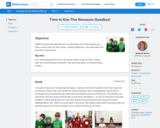
This lesson provides an opportunity for visual learns to think about segments of time during the school day.
- Subject:
- Mathematics
- Material Type:
- Lesson Plan
- Provider:
- BetterLesson
- Date Added:
- 12/01/2022

This lesson provides an opportunity for visual learns to think about segments of time during the school day.

As the result of a Unit assessment, it was found that students showed some confusion with writing time and with adding sets of coins. These skills need to be reviewed to aid in mastery of the Common Core standards for time and money.

This introduction to time allows students to explore the terms we use with time and connects telling time to measurement. Included in this lesson is a video of the lesson in action, a sample anchor chart, and a "My Day" printable booklet for students to complete.

In this lesson, students will choose their favorite from an assortment of Dr. Seuss books and state a reason why for their choice. Examples of student work are included. Students will also have fun dressing up as their favorite Dr. Seuss character for a culminating activity.

Solving equations supports algebraic thinking which is needed for high school and beyond.

Solving equations supports algebraic thinking which is needed for high school and beyond.

Solving equations supports algebraic thinking which is needed for high school and beyond.

Often, we ask students to find the main idea in the story- this helps when re-telling. Why not apply this idea to writing? Find the main idea and introduce your writing with that idea; just like with a book, it helps with re-telling! Included are specific ways to model this lesson, graphic organizers, and examples of student work.

This lesson is the sequel to Towers! Towers! Towers! 1-5. Students continue to develop their sense of quantity as they build successive taller towers.

Students will translate between the written form and algebraic form using correct mathematical notation.

Identifying 2D shapes in common objects and sorting according to shapes connects the real world to learning shape names and attributes.

Students will be able to practice working with triangles in different orientations, students will illustrate a "real world" triangular object, & build craft stick triangles.

Kindergarteners love to identify shapes in their environment. In order effectively do that, they must be able to recognize different shapes by their specific attributes. In this lesson kindergartners learn about different types of triangles.

Comparing the treatment of setting in "The Most Dangerous Game" and a movie clip. RL.9-10.7 analyze 2 media

What is the lowest elevation in United States? How would you represent it as an integer?

Students develop their understanding of multiplication by grouping objects into equal groups to model the factors and products.

Using a tape diagram is one of the key models for ratios and proportions.

Students will be able to demonstrate how much they have learned and retained during the lessons presented for unit 1.

It is important to assess students periodically to plan for future lessons to meet student needs.

Move over Van Halen because today we are all going to "Jump." So go ahead and jump as students solve an assessment piece and story problems involving jump lengths. If you are under 30, please Google Van Halen before proceeding.